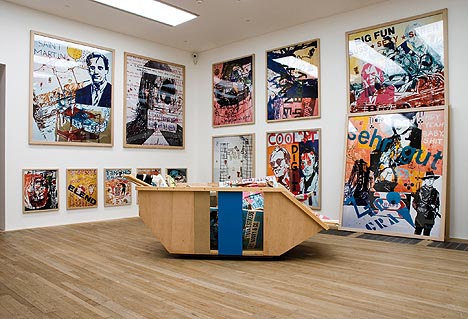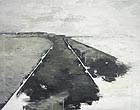
translated and summarized by: Liz Wollner-Grandville,
English summary December 15 - January 12
Lentos Museum Linz: Best of Austria – An Art Collection
Ranking without hierarchy
If the Lentos Museum, the only contemporary art museum in Linz, which is this year’s European Cultural Capital, presents an art collection, it should be something special. The museum could have easily selected works from its own outstanding collection, added a few supplementary loans, and then present an exhibition renowned both in Europe and abroad. But Director Stella Rollig decided to do things differently. She wanted to search for the “Best of Austria” and not only present Lentos’ own collection. The exhibit’s originality and uniqueness is based on these selection criteria: Stella Rollig left the selection to the directors and curators of thirty Austrian museums and collections, who each submitted three works. And they were not to choose the well-known highlights, but their personal preferences.
A kind of “Wunderkammer” (cabinet of curiosities) with the most diverse topics, times, and styles emerged. An exhibition with surprises, a collection comparable with Malraux’s imaginary museum, committed only to individual preferences. The 15th century encounters the 21st, small objects meet large canvases, and the exhibit is basically symbolic of what goes on in one’s own brain when thinking of art. Things don’t pass chronologically in your brain – one moment you may think of the Isenheimer Altar and then immediately of Keith Haring’s graffiti. The 100 works presented at “Best of Austria” are thought provoking, but also make one smile.
The charm of the selection is also underlined by Golmar Kempinger-Khatibi’s ingenious architecture. She structured the 800 m2- space so cleverly using wall elements and pedestals that new spaces seemingly emerge continuously. She offers perspectives and insights for each individual object. While the viewers are thereby tempted to become curious what will await them in the next room, the general overview is never at stake.
“Best of Austria” is both a demanding as well as an ironic title – contradiction and agreement will always balance each other. But the most remarkable thing about this presentation is that it is inquisitive – with respect to the reliability of rankings and the objectivity of art historic claims. Through this highly personal selection it suddenly becomes clear that art was not created for museums, but for people who live with these paintings and objects – in festive, representative or religious surroundings, as well as in the privacy of their homes. As Rainer Metzger points out in his catalogue text, the extraordinary facet of its “colourful lack of hierarchy” characterizes this exhibition. This allows one to discover one’s own hierarchy or one’s favourite objects, and to sometimes wonder about the selection criteria of collection curators and directors.
Angelica Bäumer
Lentos Museum Linz
4020 Linz, Ernst-Koref-Promenade, until 10.05.09
www.lentos.at
Hamburger Bahnhof – Museum für Gegenwart: Cult of the artist: „ I can’t just slice off an ear every day“. Deconstructing the myth of the artist
Deconstructing the myth
Within a total selection of 10 exhibitions of the Berlin State Museums the slogan „Cult of the artist“ marks the end of Director Peter Klaus Schuster’s time in office. On this occasion, the Hamburger Bahnhof is showing – next to a large Beuys retrospective and an Andy Warhol show – another exhibition with reference to this topic at the Rieckhallen. The group exhibit with works from the Friedrich Christian Flick, Erich Marx, and Egidio Marzona collections functions as the necessary deconstruction of myths.
Consequently the exhibition organizers fell back on a dashing work title by Martin Kippenberger. With reference to the last bow this could, however, also have been an invention by the curators: “I can’t just slice off an ear every day“. The title circles around the tragic downside of the artist’s cult: the everlasting pressure to produce something new and to always be witty and aesthetically innovative. Differing concepts intensify this phenomenon. Marcel Duchamp’s readymade Porte-bouteilles (Bottle Rack 1914) mark the starting point. The naming and presentation of a commercially available bottle dryer characterizes a weighty gesture, which considered the artistic action more important than the object itself.
The cult-like worshipping of an art object was questioned, but this act enabled an artist to revive as a genius. Duchamp’s approach in different areas takes shape within a wide spectrum ranging from parody and seriousness: Marcel Broothaers is filmed while he signs his works without letting anybody see his hand; Bruce Nauman’s neon-lit name shines contorted from a wall, and Martin Kippenberger leaves the completion of Heavy Burschi (1989 – 91) to his assistant. The myths of the individual creation by the artist or the exclusive authorship are thereby deconstructed. In contrast to the other exhibits of the Berlin State Museums, here women are given a chance. They mainly thwart the male art genius, whose prototype is presented with Paul McCarthy’s phallic parody of Jackson Pollock with his Penis Dip Painting (1974). Cindy Sherman’s role-playing, poses, and masquerades are contrasted with Rodney Graham’s figures within the same room. Explorations of female identity continue in Valie Export’s Aktionshose or lead back to a stereotype femininity image in Pipilotti Rist’s video work. Following an impressive amount of established positions, one reaches a dead end in the rear parts of the Rieckhalls: Where do we go from here? asks Ugo Rondinone with four video projected clowns. This commentary, embedded into the ambivalence of a ridiculed artist figure and the weariness of attempting to amuse the audience, does make one think.
70 picture frames, whose production Maria Eichhorn has left to others, accompany you on the long way back to the main hall. Based on the deconstruction of myths, she is also one of those who know how an artist can really be created. Seen this way, the exhibition is also a collection of highly remunerated works. And the collectors know that they, by all means, must be part of their holdings.
Marianne Wagner
Hamburger Bahnhof – Museum für Gegenwart – Berlin
10557 Berlin, Invalidenstrasse 50 – 51, until 23. 02. 09
www.hamburgerbahnhof.de
KW Institute for Contemporary Art: Political/Minimal
Political on second sight
The „Monochrome“ in Yves Klein’s patented International Klein-Blue lasts 74 minutes and demands a new kind of reflection on art. Derek Jarman shows nothing but the colour blue in his film, with the exception of occasional white dust flashes that creep into the 35mm film. In contrast to the visual monotony different speakers take turns reading excerpts from diaries written by the artist, diagnosed as HIV positive. The diary entries describe his decrepit state of health and his anxieties; they list the potential side effects of his medication, and talk about the situation of homosexuals and HIV patients as well as a reflection on the hubris of charity events.
Jarman’s work is a good example for most of the works shown in this exhibit curated by Klaus Biesenbach at the Berliner Kunst Werke, in which minimalistic form is combined with an explanatory text, through which the otherwise not obvious political content or reference is disclosed. This is how the artists differ from the minimalists of the 1960s, who accept nothing narrative, no outside world, only the work itself and the impact it has on the observer.
On the one hand this type of approach criticizes the reduced forms of Minimalism and their postulated autonomy: already in 1963 – 65 Hans Haake underlines that his “Condensation Cube” is doubtlessly closely related to its surroundings. Some works could even be seen as an ironic allusion. Francis Alys seemingly wants to bury this art movement, which is based on form and material, with his Sisyphean task showing a slowly melting minimalistic ice cube.
On the other hand, artists draw on this minimal form when they, like Jarman, don’t consider their topics presentable in a figurative form. Alfredo Jaar, for example, regarded his photos of the genocide in Ruanda as too weak, and therefore turned the front of the light boxes - in which they should have been presented - towards the wall. Now only the light escaping from the rim of these boxes reminds of the original negated function, and thereby of the non-presentable. However, the work loses its power on account of the bright walls of the Kunst Werke, their mythical light-effect is unfortunately swallowed.
In general, the question raised through the exhibition is, if each individual work would be as effective without an explanation, if it comes across as not really aesthetically innovative. The works must face the danger of being considered as visually irrelevant after 40 years of accustoming to Minimalism.
Conny Becker
KW Institute for Contemporary Art
10117 Berlin, Auguststrasse 69, until 25.0109
www.kw-berlin.de
Strabag Kunstforum: Strabag Artaward 08 – Nieves Salzmann – Traces
Free-flowing borders. Or when painting turns into sculpture
Salzmann’s current works show rows of houses and streets – all empty and abandoned, grey and drab. Although the paintings are figurative they also show abstract elements, out of which the composition then emerges; covered with a kind of blurred patina.
Some of Salzmann’s works are fascinating – but only if their elements act in their own capacity – such as, for example, two paintings, painted on thick wood and positioned in the exhibition hall at an angle, or the painting, which is cut into stripes and hangs from the ceiling. This positioning enables the works to design the space itself, and offer exciting insight into other, virtual spaces. They would, however, be much less convincing, if they were only hung on a wall. The motives of Salzmann’s paintings, as well as the way she deals with their capacity, levels, and surfaces are proof of her talent. Lets hope that she will continue to let her talent flow into her works.
Wolfgang Pichler
Strabag Kunstforum
1220 Vienna, Donau-City Strasse 9, until 16.01.09
www.strabag-kunstforum.at
Mehr Texte von translated and summarized by: Liz Wollner-Grandville


 Teilen
Teilen




